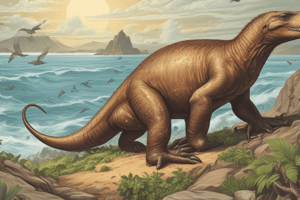Podcast
Questions and Answers
What is the primary focus of microevolution?
What is the primary focus of microevolution?
- The study of fossils and ancient organisms
- Mechanisms of climate change impacting biodiversity
- Changes in species diversity over millions of years
- Changes in allele frequencies over generations (correct)
What determines the arbitrary nature of racial categories?
What determines the arbitrary nature of racial categories?
- The evolutionary adaptations of different species
- The social constructs based on physical and cultural traits (correct)
- The genetic differences among individuals
- The biological traits that are easily distinguishable
Which of the following factors can serve as a limiter to a species' survival?
Which of the following factors can serve as a limiter to a species' survival?
- Speciation events
- Reproductive success rates
- Predation from other species (correct)
- Genetic variations within populations
What mechanism of speciation occurs due to geographic isolation?
What mechanism of speciation occurs due to geographic isolation?
Which concept describes the gradual changes in species form and numbers due to environmental adaptation?
Which concept describes the gradual changes in species form and numbers due to environmental adaptation?
How do environmental factors influence the evolution of species?
How do environmental factors influence the evolution of species?
What is the unit of study in macroevolution compared to microevolution?
What is the unit of study in macroevolution compared to microevolution?
Which process involves the creation of multiple new species from a single ancestral species?
Which process involves the creation of multiple new species from a single ancestral species?
What is the primary mechanism proposed by Darwin to explain how species evolve over time?
What is the primary mechanism proposed by Darwin to explain how species evolve over time?
Which statement accurately describes the role of competition in Darwin's view of natural selection?
Which statement accurately describes the role of competition in Darwin's view of natural selection?
What was a significant influence that led Darwin to develop his theory of gradual evolution?
What was a significant influence that led Darwin to develop his theory of gradual evolution?
Which factor does not contribute to natural selection?
Which factor does not contribute to natural selection?
What pattern was observed in the peppered moth that exemplifies the concept of industrial melanism?
What pattern was observed in the peppered moth that exemplifies the concept of industrial melanism?
What did Alfred Russel Wallace contribute to the discussion of evolution?
What did Alfred Russel Wallace contribute to the discussion of evolution?
According to the principles of Darwin's theory, what result might occur if populations remain isolated long enough?
According to the principles of Darwin's theory, what result might occur if populations remain isolated long enough?
How is the concept of environmental context important in natural selection?
How is the concept of environmental context important in natural selection?
What significant impact did the fall of the Western Roman Empire have on scholarship in Europe?
What significant impact did the fall of the Western Roman Empire have on scholarship in Europe?
Which philosopher is known for formalizing ideas that became precursors to evolutionary theory?
Which philosopher is known for formalizing ideas that became precursors to evolutionary theory?
What does the scientific method consist of when forming a theoretical model?
What does the scientific method consist of when forming a theoretical model?
What approach did ancient Greek philosophers take to understand natural phenomena?
What approach did ancient Greek philosophers take to understand natural phenomena?
How did the historical context influence the development of evolutionary thought?
How did the historical context influence the development of evolutionary thought?
What does the term 'natural selection' imply in the context of evolution?
What does the term 'natural selection' imply in the context of evolution?
Which statement best describes the role of Muslim scholars during the development of evolutionary thought?
Which statement best describes the role of Muslim scholars during the development of evolutionary thought?
What role does the environment play in the process of evolution?
What role does the environment play in the process of evolution?
Flashcards are hidden until you start studying
Study Notes
Galapagos Islands
- One of the most volcanic places on Earth.
- Crossroads of four major ocean currents, leading to high marine diversity.
- Islands formed between 700,000 and 4.2 million years ago (oldest submerged - 8 million years ago, plume - 90 million years ago)
- Geological and ecological differences are tied to the ages of the islands.
- Parallel between species morphology, behavior, geography, and adaptation to the environment.
Influences of Darwin's Work
- Lyell's Geology - Rejected the six-day creation theory.
- Thomas Robert Malthus - Many more organisms are born than can survive due to limited resources. This leads to competition and only the strong survive.
Darwin's Contribution
- Demonstrated the fact of evolution and defined it as descent with modification.
- Offered an explanatory mechanism for evolution - natural selection.
- Survival and mortality are key to natural selection.
- Natural Selection preserves favorable individual differences and variations while destroying less adaptable ones.
- Argued against a purely competitive view of evolution. He believed the success of human and animal evolution was tied to the evolution of compassion.
Alfred Russel Wallace
- Explored the Malay Archipelago from 1848 to 1862.
- In 1857, he wrote "On the Tendency of Variation to Depart Indefinitely from the Original Type," outlining his theory of evolution.
Five Parts of Natural Selection
- Heredity of most features
- Heritable variation in the population.
- Variation leads to differential survival and reproductive success among variations.
- Differential survival and reproduction leads to changes in the frequency of characters within a population (they will diverge).
- If the process continues for long enough, parent and daughter species can no longer interbreed.
Gradual Evolution
- Darwin believed in gradualism: changes happen slowly and gradually.
- This was influenced by the Uniformitarianism school of thought.
Industrial Melanism
- Peppered moth (Biston betularia) exists in two varieties: melanic and non-melanic.
- Non-melanic forms are virtually invisible against pale-colored backgrounds, while melanic forms are invisible against dark backgrounds.
- Different survival rates occur in environments with different colors.
- Before the Industrial Revolution, the lighter form dominated due to a survival advantage.
Race vs. Subspecies
- Subspecies are biological units below the level of a species.
- Race is a social construct based on physical and cultural traits used to draw arbitrary boundaries between people.
- These physical traits are continuous and do not map neatly onto racial categories.
Microevolution vs Macroevolution
Microevolution
- Time: Generations
- Units: Below species level
- Focus: Processes
- Discipline: Population genetics
- Fitness: Births and deaths of individuals
- Evolution: Changes in allele frequencies over time
- Natural Selection: Individual selection
Macroevolution
- Time: Millions of years
- Units: Above species level
- Focus: Products (patterns of organic diversity)
- Discipline: Paleobiology
- Fitness: Births and deaths of species
- Evolution: Changes in patterns of organic diversity through time
- Natural selection: Species selection
Limits of Species Existence
- Environmental factors exert selection pressure, influencing survival (fitness) of organisms and their offspring.
- This restricts where species can live.
- Limiting factors include:
- Physiological stress (too much or too little moisture, light, temperature, pH, specific nutrients)
- Competition with other species
- Predation, including parasites and diseases
- Luck
- Tolerance limits of a species indicate environmental factors beyond which a species cannot survive or reproduce.
Species Change Through Time
- Because species live within limits, change in species form and numbers occurs as organisms are forced to adapt to changing environments.
- Random change (mutation, drift) and interactions (gene flow) affect variation within a species and its ability to adapt.
- One species can change into a single new species (anagenesis) or into two or more species (cladogenesis).
- Can happen gradually or rapidly.
- Tempo: Phyletic gradualism or punctuated equilibrium.
Speciation
- Speciation is the development of new species.
- One important mechanism of speciation is geographic isolation (allopatric speciation).
- Sympatric speciation occurs when barriers dividing populations are not physical, like habitat, behavioral, or temporal isolation.
Science and Evolution
- Science is the systematic, critical exploration of material nature.
- The theory of evolution is incredibly well supported.
Scientific Method
- Observations/facts
- Hypothesis formulation
- Testability of the hypothesis
- Hypothesis testing and rejection
- Model development (set of repeatedly tested hypotheses)
- Theory (set of models)
Evolution and Biodiversity
- Evolution acted to create biodiversity.
- Time depth can be assessed through indirect evidence.
The History of Evolutionary Thought
- Evolutionary thought is much deeper than the 1700s, with roots in antiquity.
- It originated in non-European spaces, including ancient Greece, Rome, China, and the medieval Islamic world.
- Ancient philosophers like Aristotle formally formalized some of these ideas, which are precursors to evolutionary theory.
European Kingdoms after the Fall of the Western Roman Empire
- Germanic tribes attacked the vulnerable areas of outer Europe, leading to the formation of multiple kingdoms with different languages, histories, and cultures.
- This event resulted in the near-disappearance of Greek scholarship in the West due to a lack of linguistic and intellectual continuity.
- The period following the fall of the Roman Empire (476 BCE to 1000 for the Early Middle Ages, and to 1500 for all Middle Ages) is considered a dark age for Western Europe.
- Aristotle's work disappeared from Western Europe for centuries.
- The Eastern Roman Empire survived the attacks.
Studying That Suits You
Use AI to generate personalized quizzes and flashcards to suit your learning preferences.




